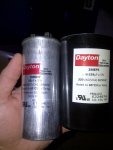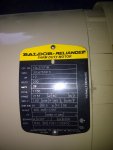wirenut1980
Senior Member
- Location
- Plainfield, IN
Hello, I have a customer who has been failing start and run capacitors at a small rural water treatment facility. The pump motor is a single phase 10 HP rated 230 V. Service is 120/240 V split phase. They have told me that ever since they bought the place (all existing equipment), these things have failed. There used to be a different start and run cap installed, but those failed in a few days. They replaced them with ones with a higher voltage rating and now they fail every few weeks. I'm not sure why they let this go for a couple years, but anyways...
I am guessing either the wrong caps are being installed, or they are wired incorrectly. I did install a monitor at the main in case there is something wrong with the supply.
I took pictures of the motor nameplate and start and run capacitor nameplates.
Can anyone tell me whether these caps are correctly specified for the motor? Anyone have any experience with these getting installed incorrectly and failing them over time? I plan on monitoring for a couple weeks and checking how the caps are installed.
Thanks!
I am guessing either the wrong caps are being installed, or they are wired incorrectly. I did install a monitor at the main in case there is something wrong with the supply.
I took pictures of the motor nameplate and start and run capacitor nameplates.
Can anyone tell me whether these caps are correctly specified for the motor? Anyone have any experience with these getting installed incorrectly and failing them over time? I plan on monitoring for a couple weeks and checking how the caps are installed.
Thanks!


